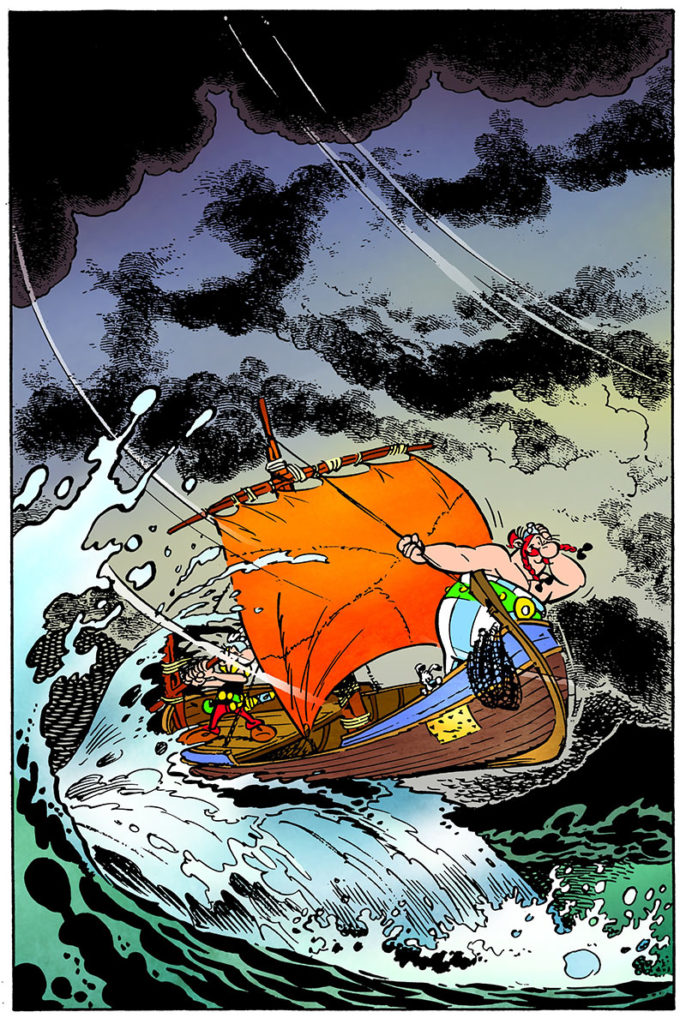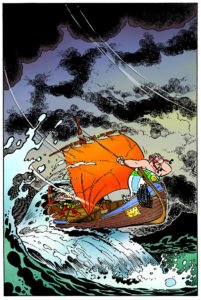Julian Maddison – First Encounters with René Goscinny

We hope you enjoy this guest blog post by Julian Maddison, an expert on all things René Goscinny. Julian is a true enthusiast and has been an invaluable source of information to us throughout the development and display of this exhibition. He has assisted us with fact-checking as well as sharing incredible stories and fascinating details about Asterix. Julian has unearthed UK-specific materials for us, such as the popular 1960s Valiant and Ranger comics, in which Asterix, pre-official translation, appears as ‘the ancient Brit with bags of grit.’ We are incredibly grateful to Julian for all his support.
Morgan Wadsworth-Boyle, Assistant Curator, Exhibitions

Image Credit: ASTERIX ® OBELIX ® IDEFIX ® DOGMATIX ®/ © 2018 LES EDITIONS ALBERT RENE / GOSCINNY-UDERZO
My first introduction to Goscinny’s work did not go well. In 1976, at the age of six, I struggled to understand the first page of Asterix and the Great Crossing. Asterix readers will know that this album begins with an entirely blank page, broken down into different sized frames, with speech bubbles coming out of the whiteness. Two ships are meeting in dense fog, the crew of each ship unaware of the presence of the other. Their conversations get intertwined and confused. In many ways this is typical of Goscinny’s work, exhibiting self-reflexivity, pushing the boundaries of the cartoon genre, and challenging the reader – all to great comic effect.
Once I got beyond page one and found myself immersed in the Gaulish village, I was hooked on Asterix. Jokes that I missed, I understood on rereading. Historical or political allusions that passed me by when a child made me laugh out loud when I came back to the books much older. Goscinny’s scripts and humour work on many levels.
Visits to France revealed there were Asterix albums that had not yet been published in English, which my father translated for me. His translations did not have the brilliance of Anthea Bell and Derek Hockridge’s English language albums, but he was translating on the spot, effectively providing footnotes as he explained the puns and allusions.
I discovered Goscinny had written Lucky Luke too – a cowboy series created and drawn by Morris. In fact, there are more Lucky Luke titles signed by Goscinny than Asterix. Morris’ artwork is as exquisite as Uderzo’s drawings for Asterix, but more restrained, and Goscinny’s texts reflect this aesthetic – Lucky Luke relies more on situation comedy and parody.
The Oxford Professor of Armenian, Charles Dowsett, purchased Asterix books in different languages, a practise I continue today. One day he told me Goscinny wrote something else and handed me a copy of the first Iznogoud book. That evening my father translated it for me and we were introduced to a world of magic, flying carpets, and intricate wordplay brought to life by Tabary’s energetic drawings.
By now, I also knew of Goscinny’s work with Sempé for the Nicholas books – a first-person narrative of equal genius to P.G. Wodehouse’s Bertie Wooster.
In 1980 we moved to France where I found not only more adventures of Iznogoud and Nicholas, but numerous other albums penned by Goscinny including the Dingodossiers, Signor Spaghetti, and Oumpah-Pah. That year also saw the publication of the first Asterix and Lucky Luke books after Goscinny’s death. The artistry of Uderzo and Morris remained intact, but even as a ten-year-old, I could see that the magic of Goscinny was missing.
I found biographies of Goscinny which listed unobtainable works such as Dick Dicks, Pistolin or Jehan Pistolet, and made it my mission to try to find these – years later having to buy hundreds of magazines to get a sequence of serialised pages. These early works informed Goscinny’s later output and there are always some fantastic lines or interaction between words and image. Further reading revealed Goscinny’s influence on the development of the Franco-Belgian cartoon industry and how he used Pilote, the magazine he edited (and which had published Asterix and Nicholas from the start), as a vehicle to promote new talent including artists whose work might not be to his taste but he considered important or impactful.
Even today, more than forty years after his death, cartoonists he supported speak warmly about Goscinny and his influence on them.
As Tabary once said, Hergé (author of Tintin) may have popularised “la bande dessinée” but Goscinny gave it status.
It has been a delight to work with the team at the Jewish Museum on the exhibition Asterix in Britain – the Life and Work of René Goscinny. It is exciting to see so much original material being exhibited in Britain for the first time. I hope that I am paying back some of the great pleasure his work has given me all these years by helping introduce some of the lesser-known aspects of his life and work to a British audience.